 By John jackson Miller
By John jackson Miller
[reprinted with permission from Comichron.com]
The final comics sales estimates for April are out from Diamond Comic Distributors, and as reported here on Friday, Amazing Spider-Man Vol. 3 #1 was the best-selling title in the last 15 years in the comics market overall, and since the mid-1990s if we’re looking at just the comics shop market. (It was definitely a high-interest issue, as Friday’s post within a day became the most-read article in this site’s history!) With the new information, Comichron estimates that Marvel sold retailers nearly 532,600 copies of the $5.99 comic book, including all its different variant cover editions. Click to see the sales estimates for comics ordered in April 2014.

Some have noted that to a far greater degree than many previous top entrants on the record-setter list, sales of Amazing Spider-Man Vol. 3 #1 were largely boosted by retailers ordering many copies in order to earn incentive special editions. That’s true, but the practice is nothing new — and, in fact, every comic book Diamond sells retailers has a sales incentive attached: the more copies retailers order, the higher their discount gets. Amazing certainly lies on the extreme in its use of incentives, but if we’re handing out asterisks based on the presence of promotions, the historical records will be replete with them.
RECORDS: In addition to the performance of the top-selling title this month, April set some new marks, one of which is reflected on the Diamond-era records page:
• April saw the highest weighted average price for comic books ordered by retailers within the Top 300 — exactly $4 even, blowing away the previous record of $3.77. (We get this number by dividing the total dollars spent on comics in the Top 300 by the total number of Top 300 comics sold.)
This huge jump is entirely due to Amazing Spider-Man #1 and Marvel’s Deadpool #27, which had a $9.99 cover price: excising those two titles, the average weighted price is just $3.78. There’s not much of a case to be made for either issue — even Deadpool, at 100 pages — to not being included in the comics list, however: each is simply a special issue of an ongoing series, and there have been plenty of 100-page specials before.
It should be noted that we’ve seen many past occasions where a special issue bumps the average price far ahead briefly. The first time the weighted average passed $3 was December 2001, when the $7.95 Dark Knight Strikes Again #1 distorted the pricing curve. But the average weighted price was not to go above $3 for good until more than four years later.
The average weighted price went above $2 for the first time, incidentally, sometime before 1996.
• Marvel’s dollar sales of Top 300 comics reached $14.79 million, its highest figure seen in the Diamond Exclusive Era, which began in 1997. The records page does not track these individual marks for publishers, but we do keep tabs on them internally at Comichron.
The aggregate changes:
April 2014: 6.98 million copies
Versus 1 year ago this month: +3%
Versus 5 years ago this month: +4%
Versus 10 years ago this month: +9%
Versus 15 years ago this month: +11%
YEAR TO DATE: 25.28 million copies, -9% vs. 2013, +8% vs. 2009, +9% vs. 2004, +2 vs. 1999
ALL COMICS UNIT SALES
April 2014 versus one year ago this month: +6.96%
YEAR TO DATE: -6.91%
—
April 2014: $25.28 million
Versus 1 year ago this month: -9%
Versus 5 years ago this month: +8%
Versus 10 years ago this month: +9%
Versus 15 years ago this month: +2%
YEAR TO DATE: $95.96 million, -4% vs. 2013, +22% vs. 2009, +44% vs. 2004, +52% vs. 1999
ALL COMICS DOLLAR SALES
April 2014 versus one year ago this month: +17.37%
YEAR TO DATE: -0.89%
—
April 2014: $7.58 million
Versus 1 year ago this month: -14%
Versus 5 years ago this month: -3%
Versus 10 years ago this month, just the Top 100 vs. the Top 100: +47%
Versus 15 years ago this month, just the Top 25 vs. the Top 25: +16%
YEAR TO DATE: $28.21 million, -11% vs. 2013
ALL TRADE PAPERBACK SALES
April 2014 versus one year ago this month: +16.78%
YEAR TO DATE: +5.44%
—
April 2014: $35.54 million
Versus 1 year ago this month: +8%
Versus 5 years ago this month: +7%
Versus 10 years ago this month, counting just the Top 100 TPBs: +41%
Versus 15 years ago this month, counting just the Top 25 TPBs: +85%
YEAR TO DATE: $124.18 million, -5% vs. 2013
ALL COMICS AND TRADE PAPERBACK SALES
April 2014 versus one year ago this month: +17.18%
YEAR TO DATE: +1.04%
—
April 2014: approximately $48.17 million (subject to revision)
Versus 1 year ago this month: +17%
Versus 5 years ago this month: +15%
Versus 10 years ago this month: +80%
YEAR TO DATE: $164.77 million, +1% vs. 2013
RELEASES
New comic books released: 481
New graphic novels released: 299
New magazines released: 63
All new releases: 843
As noted above, the average comic book in the Top 300 cost $3.72; the average comic book retailers ordered cost $4.00. The median and most common price for comics offered was $3.99. Click to seecomics prices across time.
One curiosity in the charts: sales of graphic novels in the Top 300 were off 14% against last April, whereas Diamond reported that sales for the category overall were up nearly 17%. There’s no disconnect here. The first measure is calculated based on full price of everything sold, whereas Diamond’s overall figure is based on wholesale prices, or what it received from retailers. As last April’s report notes, Marvel put a lot of hardcovers into the market back then at deep discounts, which is why the Top 300 dollar value was inflated. This April’s total more realistically reflects what was sold.
The 300th-place comic book, incidentally, sold almost exactly 1% of the units that the #1 comic book sold. That’s a spread we haven’t seen in a long time (and it’s not a bad thing, as the 300th-place book still sold over 5,000 copies).
Next month’s report will reflect any reorders from Amazing #1, as well as sales activity spurred by Free Comic Book Day. Find your local comic shop here.
John Jackson Miller has tracked the comics industry for more than 20 years, including a decade editing the industry’s retail trade magazine; he is the author of several guides to comics, as well as more than a hundred comic books for various franchises. He is the author of the New York Times bestseller Star Wars: Kenobi and the upcoming hardcover Star Wars: A New Dawn. Visit his fiction site at http://www.farawaypress.com. And be sure to follow Comichron on Twitter and Facebook!


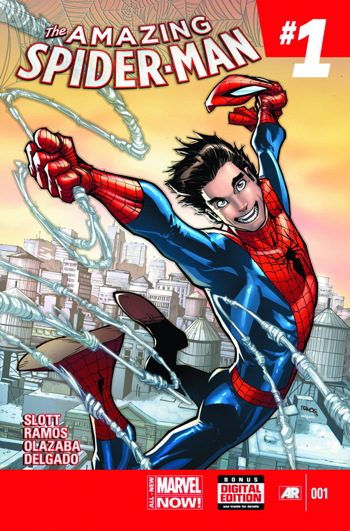
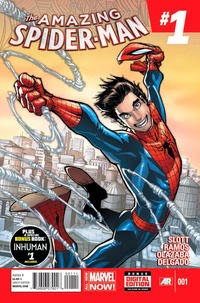 B
B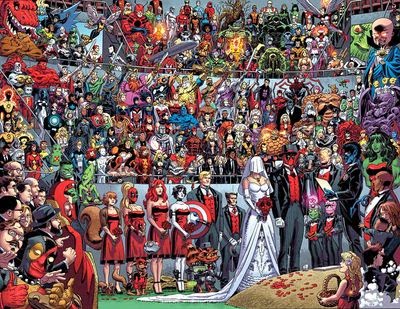


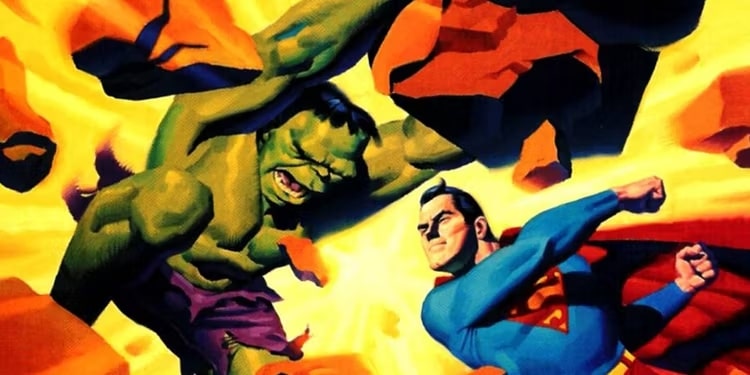

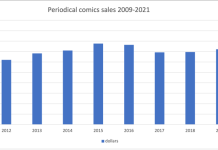



That has to be the one of the worst Spider-Man covers I’ve ever seen. The eyes are oddly mismatched ( 2 different sized pupils?) adding to the lunatic expression of the face. Is he supposed to be happy? Maybe apt for these times, Peter Parker looks like he’s gone insane over Marvel’s greed and gimmicks, that depressing yearly reach into the fanboy trough to compensate for its lack of artistry and further dilute ts best character. Why they keep being rewarded for tricks and marketing strategy probrably explains why people keep electing the Congress that is out ruin us.
$6? I can’t say I vouch for the business after this. If the floppy has to go, so be it. This really goes with the movies aura.
I’d love to see a follow-up article where TheBeat contacted a large amount of retailers and found out how many copies were still on the stands.
It pains me that $2.99 is now considered value-priced.
It’s worth noting that both Amazing Spider-Man #1 and Deadpool #1 were both 100-page issues — probably the better way to judge pricing across time is just to look at the 32-page issues. I ran the pricing numbers subtracting those two comics out, but there were certainly other giant-sized apples in with the regular apples.
“That’s true, but the practice is nothing new — and, in fact, every comic book Diamond sells retailers has a sales incentive attached: the more copies retailers order, the higher their discount gets”
I mean, TECHNICALLY that’s true… but PRACTICALLY? Marvel averages sales over a TWELVE MONTH period, so it takes QUITE A WHILE for your sales increases to register and roll over.
To put it in a more specific way, I’m about to celebrate the six-month anniversary of purchasing a second ongoing and active store with a customer base about the size of the original, and I STILL have NOT received any of the increased-Marvel-Discount that I “should have” received based upon the new combined volume.
DC has a rolling six-month average, which is better, but for them we’re nowhere near the threshold for the next discount bracket. It would take opening a third store to move up.
Once you hit the “higher” discount tiers, the amount you’d need to change your orders is really a TREMENDOUS hill to climb, and one that pays no dividends for months upon a time.
“The More You Know!”
-B
“I’d love to see a follow-up article where TheBeat contacted a large amount of retailers and found out how many copies were still on the stands.”
Speaking as someone who didn’t order an exclusive cover; and more than tripled orders from SSM #29, our sell-through has been strong, and we’re very close to having to reorder more copies.
We also probably could have sold 2x the number of Skottie Young covers we ordered (which was, generally, a third of our total orders) — those blew out crazy fast.
On the other hand, my prediction is ASM will be selling less than SUPERIOR SPIDER-MAN by… issue #4.
Parker coming back is, to me, sort of like Barry Allen returning as Flash — folks were excited for a second, but then went “Oh, yeah, he’s dull”, and rapidly walked away.
-B
-B
“Sales Chart” tag seems to be missing from the article.
Mr. Hibbs,
I see the percentages listed in the Previews order form, for various publishers, but nothing for Diamond in general.
Are you at liberty to post those tiers?
And, in general, how much difference to your bottom line does that extra percentage point make?
Torsten:
“Diamond in general” is pretty meaningless — non-brokered discounts max out at 50%, or at least it has since CEREBUS stopped running (CEREBUS was 55%).
“And, in general, how much difference to your bottom line does that extra percentage point make?”
A pretty significant one, that being pure profit at that point.
(or at least pretty much)
-B
@ Brian – thanks for contributing your analysis. I honestly love tilting at windmills and think your data-driven approach to both ordering comics and writing about them is very important to the industry.
@johnrobiethecat – Okay, so it’s not just me. I normally love Humberto Ramos’ art, but that cover is just… garish.
Agreed on Brian’s point. I would think that for stores at the low end of the brackets the next threshold is an easier walk: I’d guess that the New 52, taking place line-wide over a sustained period, likely moved some of those stores up a bracket for however long. But the larger point was one of historic comparison — and I do seem to remember in the early days it was easier to game discounts at certain distributors by bulking up on “hot titles”. I’d have to go dig around in the orderbook paperwork to see for sure — what I have of it — but I recall there were outfits where discounts were set by whatever the volume of a particular order was.
“@johnrobiethecat – Okay, so it’s not just me. I normally love Humberto Ramos’ art, but that cover is just… garish.”
@Jeremy Holstien –
I hate to dog artists but it was just so off-putting as a cover. I’m sure he’s good on better days with that kind of style. Who knows, might have been edited by committee or it could be the colorist choices. Kind of has a 99-cent store, Spidey & His Amazing Friends DVD jacket thing going on. Judging by sales, guess it did the job.
JJ: the 6-month window for DC and 12-month for Marvel makes that “gaming” to be EXTREMELY tricky. Image and DH discounts (and Diamond for that matter) are “grandfathered” at whatever they were umpty years ago, but if you’re a newer account it is *possible* you’re locked it at keystone-max for the “Lesser” brokered pubs.
-B
Thanks. I still think the point is correct when referring to the list of titles on the historical record list, which would take us back before the umpty years ago and the current windows — back in the multi-distributor days. I seem to recall outfits that calculated discounts in the same month books were ordered, in which case, that would equate to a sales incentive on titles for which no incentive variants existed. I could swear I remember listening to a retailer describing his strategy in ordering 1980s black-and-white boom era books — he’d order heavy on whatever would get him to his next bracket, so those chancy books would be basically free.
Comments are closed.